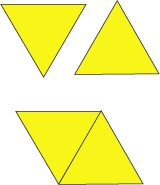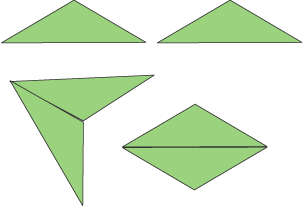Copyright © University of Cambridge. All rights reserved.
'Putting Two and Two Together' printed from https://nrich.maths.org/
Show menu
Why do this problem?
This problem encourages children to work in a systematic way to find all possibilities and it gives a context for analysing properties of triangles.
It is essential to have cut-out triangles available for the children to manipulate while working on this problem. You can print off these sheets, if possible on coloured card.
Possible approach
A good way to introduce the problem would be for children themselves to investigate the different ways (in fact only one) you can put two yellow (equilateral) triangles together. This will allow you to emphasise what we mean by "different".
When looking at two green triangles, you could ask children to work in pairs. How do they know they have all the possibilities? You could invite some pairs to share the ways that they had worked systematically in order to know they hadn't missed any out.
Then give everyone an opportunity to predict how many ways two blue triangles can be fitted together - ask them to think carefully on their own, then chat to a partner, then talk about their predictions as a class. In discussion, encourage pupils to justify their predictions and then invite them to test them out.
Key questions
How many ways have you found for putting together the yellow/ green/ blue triangles?
How do you know you have found all the possible ones?
Can you think of a reason why this is so?
How many sides of different lengths does that triangle have?
Possible extension
Learners could try using three copies of each triangle instead of two.
Possible support
Suggest using cut-out triangles to manipulate and then draw round. These can be printed off on coloured card.


